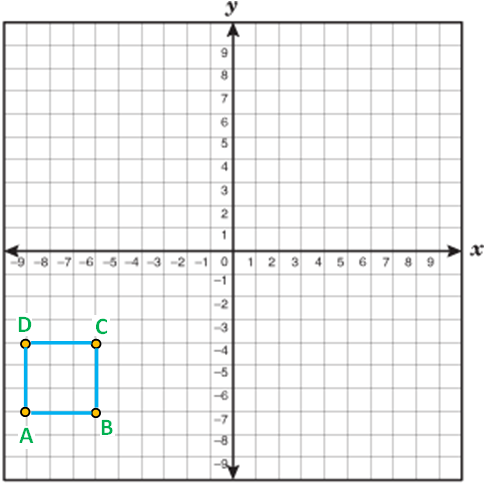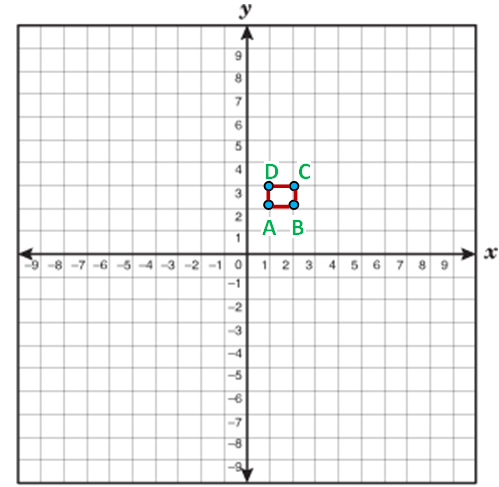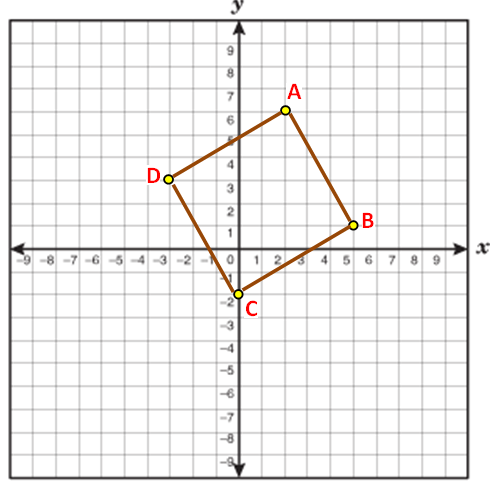VERTICES OF SQUARE WORKSHEET
Subscribe to our ▶️ YouTube channel 🔴 for the latest videos, updates, and tips.
Examine whether the given points forms a square.
(i) (-9, -7), B (-6, -7), C (-6, -4) and D (-9, -4)
(ii) A (1, 2) and B (2, 2) and C (2, 3) and D (1, 3)
(iii) A (2, 6), B (5, 1), C (0, -2) and D (-3, 3)
Detailed Solution
Question 1 :
Examine whether the given points
A (-9, -7), B (-6, -7), C (-6, -4) and D (-9, -4)
form a square.
Solution :
Step 1 :

Step 2 :
Finding the length of all sides.
Distance Between Two Points (x1, y1) and (x2, y2)
√(x2 - x1)2 + (y2 - y1)2
Length of side AB :
Here x1 = -9, y1 = -7, x2 = -6 and y2 = -7
= √(-6-(-9))² + (-7-(-7))²
= √(-6+9)² + (-7+7)²
= √3² + 0²
= √9
= 3 units ---(1)
Length of side BC :
Here x1 = -6, y1 = -7, x2 = -6 and y2 = -4
= √(-6-(-6))² + (-4-(-7))²
= √(-6+6)² + (-4+7)²
= √0² + 3²
= √9
= 3 units ---(2)
Length of side CD :
Here x1 = -6, y1 = -4, x2 = -9 and y2 = -4
= √(-9-(-6))² + (-4-(-4))²
= √(-9+6)² + (-4+4)²
= √(-3)² + 0²
= √9
= 3 units ---(3)
Length of side DA :
Here x1 = -9, y1 = -4, x2 = -9 and y2 = -7
= √(-9-(-9))² + (-7-(-4))²
= √(-9+9)² + (-7+4)²
= √0² + 3²
= √9
= 3 units ---(4)
(1) = (2) = (3) = (4)
Length of all sides are equal.
Step 3 :
Length of diagonal AC :
Here x1 = -9, y1 = -7, x2 = -6 and y2 = -4
= √(-6-(-9))2 + (-4-(-7))2
= √(-6+9)² + (-4+7)²
= √3² + 3²
= √9 + 9
= √18 units
Length of diagonal BD :
Here x1 = -6, y1 = -7, x2 = -9 and y2 = -4
= √(-9-(-6))2 + (-4-(-7))2
= √(-9+6)2 + (-4+7)2
= √(-3)2 + 32
= √9 + 9
= √18 units
Length of diagonal AC = Length of diagonal BD
So, the given points are vertices of square.
Question 2 :
Examine whether the given points
A (1, 2), B (2, 2), C (2, 3) and D (1, 3)
forms a square.
Solution :
Step 1 :

Step 2 :
Let the given points are A (1, 2) and B (2, 2) and C (2, 3) and D (1, 3).
Length of side AB :
Here x1 = 1, y1 = 2, x2 = 2 and y2 = 2
= √(2-1)² + (2-2)²
= √(1)² + (0)²
= √1 + 0²
= 1 unit ----(1)
Length of side BC :
Here x1 = 2, y1 = 2, x2 = 2 and y2 = 3
= √(2-2)² + (3-2)²
= √(0)² + (1)²
= √0² + 1
= 1 unit ----(2)
Length of side CD :
Here x1 = 2, y1 = 3, x2 = 1 and y2 = 3
= √(1-2)² + (3-3)²
= √(-1)² + (0)²
= √1 + 0²
= 1 unit ----(3)
Length of side CD :
Here x1 = 1, y1 = 3, x2 = 1 and y2 = 2
= √(1-1)² + (2-3)²
= √(0)² + (-1)²
= √0 + 1
= 1 unit ----(4)
(1) = (2) = (3) = (4)
Step 3 :
Length of diagonal AC :
Here x1 = 1, y1 = 2, x2 = 2 and y2 = 3
= √(2-1)² + (3-2)²
= √(1)² + 1²
= √1 + 1
= √2 units
Length of diagonal BD :
Here x1 = 2, y1 = 2, x2 = 1 and y2 = 3
= √(1-2)2 + (3-2)2
= √(-1)2 + (1)
= √1 + 1
= √2 units
Length of diagonal AC = Length of diagonal BD
So, the given points are vertices of square.
Question 3 :
Examine whether the given points
A (2, 6), B (5, 1), C (0, -2) and D (-3, 3)
forms a square.
Solution :
Step 1 :

Step 2 :
Finding the length of all sides.
Distance Between Two Points (x1, y1) and (x2, y2)
√(x2 - x1)2 + (y2 - y1)2
Four points are A (2,6) and B (5,1) and C (0,-2) and D (-3,3)
Length of AB :
Here x1 = 2, y1 = 6, x2 = 5 and y2 = 1
= √(5-2)2 + (1-6)2
= √32+(-5)2
= √9+25
= √34 units ----(1)
Length of BC :
Here x1 = 5, y1 = 1, x2 = 0 and y2 = -2
= √(0-5)2 + (-2-1)2
= √(-5)2 + (-3)2
= √(25 + 9)
= √34 units ----(2)
Length of CD :
Here x1 = 0, y1 = -2, x2 = -3 and y2 = 3
= √(-3-0)² + (3-(-2))²
= √(-3)² + (3+2)²
= √9 + 25
= √34 units ----(3)
length of DA :
Here x1 = -3, y1 = 3, x2 = 2 and y2 = 6
= √(2-(-3))² + (6-3)²
= √5² + 3²
= √25 + 9
= √34 units ----(4)
Step 3 :
Length of diagonal AC :
Here x1 = 2, y1 = 6, x2 = 0 and y2 = -2
= √(0-2)² + (-2-6)²
= √(-2)² + (-8)²
= √4 + 64
= √70 units
Length of diagonal BD :
Here x1 = 5, y1 = 1, x2 = -3 and y2 = 3
= √(-3-5)² + (3-1)²
= √(-8)² + (2)²
= √64 + 4
= √70 units
Length of diagonal AC = Length of diagonal BD
So, the given points are vertices of square.
Subscribe to our ▶️ YouTube channel 🔴 for the latest videos, updates, and tips.
Kindly mail your feedback to v4formath@gmail.com
We always appreciate your feedback.
About Us | Contact Us | Privacy Policy
©All rights reserved. onlinemath4all.com

Recent Articles
-
ASTC Formula in Trigonometry
Dec 23, 25 11:34 PM
ASTC Formula in Trigonometry - Concepts - Examples and Solved Problems -
Coin Tossing Probability
Dec 23, 25 11:29 PM
Coin Tossing Probability - Concept - Sample Space - Formula - Solved Problems -
Permutation and Combination
Dec 23, 25 11:28 PM
Permutation and Combination - Definition - Formulas - Shortcuts - Difference between permutation and combination
